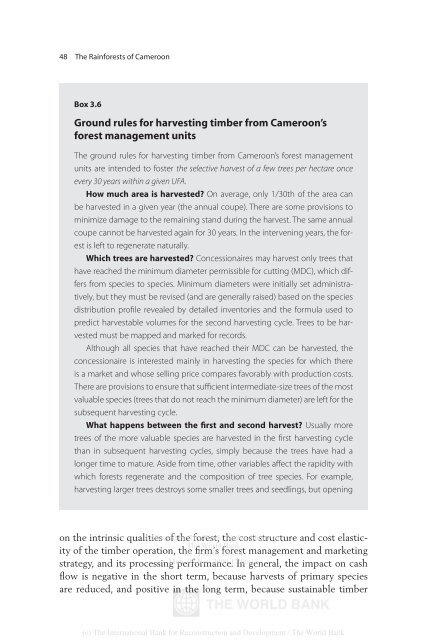The Rainforests of Cameroon - PROFOR
The Rainforests of Cameroon - PROFOR
The Rainforests of Cameroon - PROFOR
- No tags were found...
You also want an ePaper? Increase the reach of your titles
YUMPU automatically turns print PDFs into web optimized ePapers that Google loves.
48 <strong>The</strong> <strong>Rainforests</strong> <strong>of</strong> <strong>Cameroon</strong>Box 3.6Ground rules for harvesting timber from <strong>Cameroon</strong>’sforest management units<strong>The</strong> ground rules for harvesting timber from <strong>Cameroon</strong>’s forest managementunits are intended to foster the selective harvest <strong>of</strong> a few trees per hectare onceevery 30 years within a given UFA.How much area is harvested? On average, only 1/30th <strong>of</strong> the area canbe harvested in a given year (the annual coupe). <strong>The</strong>re are some provisions tominimize damage to the remaining stand during the harvest. <strong>The</strong> same annualcoupe cannot be harvested again for 30 years. In the intervening years, the forestis left to regenerate naturally.Which trees are harvested? Concessionaires may harvest only trees thathave reached the minimum diameter permissible for cutting (MDC), which differsfrom species to species. Minimum diameters were initially set administratively,but they must be revised (and are generally raised) based on the speciesdistribution pr<strong>of</strong>ile revealed by detailed inventories and the formula used topredict harvestable volumes for the second harvesting cycle. Trees to be harvestedmust be mapped and marked for records.Although all species that have reached their MDC can be harvested, theconcessionaire is interested mainly in harvesting the species for which thereis a market and whose selling price compares favorably with production costs.<strong>The</strong>re are provisions to ensure that sufficient intermediate-size trees <strong>of</strong> the mostvaluable species (trees that do not reach the minimum diameter) are left for thesubsequent harvesting cycle.What happens between the first and second harvest? Usually moretrees <strong>of</strong> the more valuable species are harvested in the first harvesting cyclethan in subsequent harvesting cycles, simply because the trees have had alonger time to mature. Aside from time, other variables affect the rapidity withwhich forests regenerate and the composition <strong>of</strong> tree species. For example,harvesting larger trees destroys some smaller trees and seedlings, but openingon the intrinsic qualities Delivered <strong>of</strong> the by <strong>The</strong> forest, World the Bank cost e-library structure to: and cost elasticity<strong>of</strong> the timber operation, the IP : firm’s 192.86.100.34 forest management and marketing<strong>The</strong> World Bankstrategy, and its processing Mon, performance. 09 Nov 2009 17:06:18 In general, the impact on cashflow is negative in the short term, because harvests <strong>of</strong> primary speciesare reduced, and positive in the long term, because sustainable timber(c) <strong>The</strong> International Bank for Reconstruction and Development / <strong>The</strong> World Bank
















